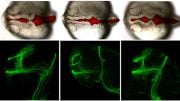
Insomnia is a sleep disorder characterized by difficulty falling asleep or staying asleep, leading to chronic fatigue and impaired daytime functioning. It can be caused by a variety of factors, including stress, anxiety, depression, medical conditions, and unhealthy sleep habits.
Texas A&M biologist Alex Keene and his team used variant-to-gene mapping, a predictive genomics approach, to demonstrate that the gene Pig-Q plays a role in regulating sleep in humans, flies, and zebrafish.
An effort funded by the National Institutes of Health, comprising of researchers from Texas A&M University, the Perelman School of Medicine at the University of Pennsylvania, and Children’s Hospital of Philadelphia (CHOP), has employed human genomics to discover a novel genetic pathway that regulates sleep in humans and fruit flies. This breakthrough could lead to the development of new treatments for insomnia and other sleep-related disorders.
Texas A&M geneticist and evolutionary biologist, Alex Keene, worked with Allan Pack and Philip Gehrman from the University of Pennsylvania and Struan Grant from Children’s Hospital of Philadelphia (CHOP) on the innovative research. Their findings were recently published in the journal Science Advances.
“There have been enormous amounts of effort to use human genomic studies to find sleep genes,” Keene said. “Some studies have hundreds of thousands of individuals. But validation and testing in animal models is critical to understanding function. We have achieved this here, largely because we each bring a different area of expertise that allowed for this collaboration’s ultimate effectiveness.”
Keene says the most exciting thing about the team’s work is that they developed a pipeline starting not with a model organism, but with actual human genomics data.
“There is an abundance of human genome-wide association studies (GWAS) that identify genetic variants associated with sleep in humans,” Keene said. “However, validating them has been an enormous challenge. Our team used a genomics approach called variant-to-gene mapping to predict the genes impacted by each genetic variant. Then we screened the effect of these genes in fruit flies.
“Our studies found that mutations in the gene Pig-Q, which is required for the biosynthesis of a modifier of protein function, increased sleep. We then tested this in a vertebrate model, zebrafish, and found a similar effect. Therefore, in humans, flies, and zebrafish, Pig-Q is associated with sleep regulation.”
Keene says the team’s next step is to study the role of a common protein modification, GPI-anchor biosynthesis, on sleep regulation. In addition, he notes that the human-to-fruit flies-to-zebrafish pipeline the team developed will allow them to functionally assess not only sleep genes but also other traits commonly studied using human GWAS, including neurodegeneration, aging, and memory.
“Understanding how genes regulate sleep and the role of this pathway in sleep regulation can help unlock future findings on sleep and sleep disorders, such as insomnia,” said Gehrman, an associate professor of clinical psychology in psychiatry at Penn and a clinical psychologist with the Penn Chronobiology and Sleep Institute. “Moving forward, we will continue to use and study this system to identify more genes regulating sleep, which could point in the direction of new treatments for sleep disorders.”
Keene’s research within his Center for Biological Clocks Research-affiliated laboratory lies at the intersection of evolution and neuroscience, with a primary focus on understanding the neural mechanisms and evolutionary underpinnings of sleep, memory formation, and other behavioral functions in fly and fish models. Specifically, he studies fruit flies (Drosophila melanogaster) and Mexican cavefish that have lost both their eyesight and ability to sleep with the goal of identifying the genetic basis of behavioral choices which factor into human disease, including obesity, diabetes, and heart disease.
Reference: “Variant-to-gene mapping followed by cross-species genetic screening identifies GPI-anchor biosynthesis as a regulator of sleep” by Justin Palermo, Alessandra Chesi, Amber Zimmerman, Shilpa Sonti, Matthew C. Pahl, Chiara Lasconi, Elizabeth B. Brown, James A. Pippin, Andrew D. Wells, Fusun Doldur-Balli, Diego R. Mazzotti, Allan I. Pack, Phillip R. Gehrman, Struan F.A. Grant and Alex C. Keene, 6 January 2023, Science Advances.
DOI: 10.1126/sciadv.abq0844
The study was funded by the National Institutes of Health.









Be the first to comment on "Sleep Soundly: New Insights Could Pave the Way for Novel Treatments for Insomnia"